TEST BED


TESTING METHODOLOGY

Thanks to XMP 3.0 and EXPO profiles the only thing one needs to do in order to run a brand new RAM kit at its advertised frequency, timings and voltages is to choose/enable it from within the BIOS and reboot. That being said if you're into overclocking you may not wish to use the main XMP/EXPO profile but instead to choose your very own frequency, timings and voltages to achieve even higher performance numbers and that's exactly what we'll also be doing during our DDR5 tests. To be more specific aside testing each kit with its XMP profile I'll also be upping the voltages (up to 1.4V for 1.35V kits – even though most kits can function at higher voltages I don’t recommend doing so - RAM modules that use 1.4V/1.45V/1.5V will be tested up to 1.45V/1.5V/1.55V respectively) and frequencies (200MHZ increments) until i find the maximum achievable stable frequency (those results will be entered into the OC charts). I also thought about upping voltages and reducing timings instead of increasing the frequency of the modules as high as it can go (always stable and without using 0.5-1V over stock) but the end results are pretty much identical.
As for the how I'll be testing each DDR5 Dual-Kit to arrive in the lab well there aren't that many benchmark programs that only test RAM (or at least RAM and CPU without anything else coming into play) but I’ve got most of them and so you will be seeing results from following benchmarking programs, AIDA64 Engineer Edition, Cinebench Release 23, MaxMemm2, Passmark Performance Test v10.1, Sisoftware Sandra Titanium and WPrime v2.11. All tests are performed on a fresh Windows 10 Pro x64 installation (complete with all updates until the day of this review) and are repeated a total of 6 times after which the average numbers get recorded into the charts.
* Since you all decided for me to use the Intel Core I9-13900K for graphics cards tests I’ll also be using that for DDR5 tests (5.8GHz P-Cores / 4.7GHz E-Cores / RING 4.9GHz) and in order to showcase potential gains between stock and overclocked clocks/frequencies I’ll also be using Forza Horizon 5 (1080p/Extreme Graphics). Still do keep in mind that i can't dedicate a high-end GPU solely for DDR5 reviews so each time i review such a kit I’ll be using a different chart (the card used will be listed above).

 O-Sense
O-Sense







.png)

